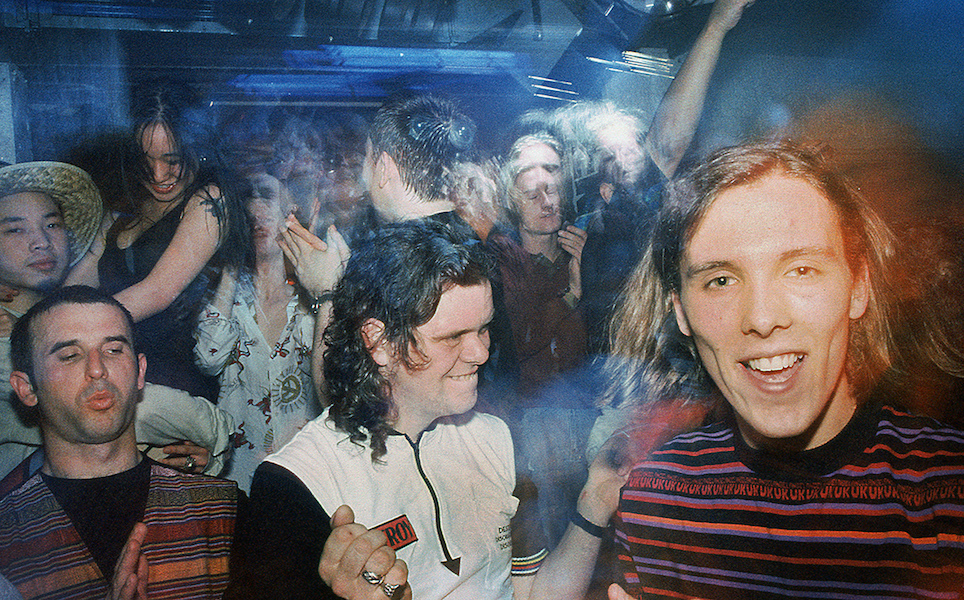Photos capturing the blissful hedonism of ‘90s rave culture
- Text by Joseph Marczynski
- Photography by Tony Davis

Demonised by the tabloid press and pursued by a police force still reeling from a bloody war on the miners, rave culture was an affront to the Thatcherite ideals of the ’80s. Shunning individualism for community, this period was defined by iconic music, potent drugs and shared, ethereal hedonism.
Photographer Tony Davis spent a brief period of his career capturing incredible shots from the clubs, warehouse parties and service stations of the Midlands’ rave scene.
Documenting these transient, iconic moments in British culture came naturally to Davis. After spending his youth engrained in the counter culture of punk and northern soul, his ability to recognise the coming of a new era was instinctive. “Seeing bands, going to clubs, dancing – then house music came along in the mid-80s,” he recalls.
Davis worked as an engineer as the burgeoning scene emerged, before being laid off. He took this opportunity to embark on a creative path, but his early aspirations to become a cinematographer were scuppered by a lack of funds. The film school fees “were the price of a council house”, leaving him with few options.

Nottingham 1990

Eclipse, Coventry 1991
He found inspiration on a trip to Ibiza in ’89. Here he visited Amnesia and Café Del Mar, and was entranced by the clubs, culture, and clientele – the “groups of young kids in their dungarees and kickers”.
After returning home and enrolling at college in his native Nottingham, Davis started attending raves with his camera. “The house music clubs in the mid-80s onwards and going to Ibiza, that set the route for going out and photographing it. The rave scene was happening and I’d already experienced it. It was irresistible, really.”
Davis quickly discovered a distinctive style, with a knack for capturing candid shots of the unbridled joy within the crowd. “It’s a bit of an inobtrusive technique I was employing at the time. Rather than ploughing in with a camera and flashes going off, I’d go mill around and have a look around. I’d see an interesting group of people, dance near them for a bit, then boom, take one, two, three, then I’d disappear.”
The photos lay dormant in damp garages and dusty attics for decades, until Davis established an Instagram account and began sharing them in late 2019. The response was immediate – especially from former ravers. “The rawness of the images – very few of them got published. It’s nice that people like them now.”

Ravers at Motorway Services 1992

Nottingham 1992
The almost celestial nostalgia for this period is evident in the comments – people finding themselves or friends in Davis’ photos, reliving memories of treasured nights and sharing the clubs and DJs that defined their youth.
Pontificating about how social media or smartphones has ruined nightlife is another common reaction to Davis’ images. This ‘90s exceptionalism isn’t something he subscribes to. “I want my stuff to connect with this current generation, the generation of ten years ago and the generation of twenty years ago. Rather than go ‘this was the best era, it’s shit now’.”
The reaction Davis treasures the most is triggering flashbacks to this period of freedom. “They see themselves – there’ve had time to pause, thirty years of working in a job, having kids and everything else, and that one picture has taken them back. This picture is how they felt.”

Venus, Nottingham, 1991

Venus, Nottingham, 1991

Sandbach services, 1991

Eclipse, Coventry 1991

Coventry 1991

Nottingham 1990
Prints of Tony Davis’ rave photography are available from the British Culture Archive.
Follow Joseph Marczynski on Twitter.
Enjoyed this article? Like Huck on Facebook or follow us on Twitter.
Latest on Huck

From his skating past to sculpting present, Arran Gregory revels in the organic
Sensing Earth Space — Having risen to prominence as an affiliate of Wayward Gallery and Slam City Skates, the shredder turned artist creates unique, temporal pieces out of earthly materials. Dorrell Merritt caught up with him to find out more about his creative process.
Written by: Dorrell Merritt

In Bristol, pub singers are keeping an age-old tradition alive
Ballads, backing tracks, beers — Bar closures, karaoke and jukeboxes have eroded a form of live music that was once an evening staple, but on the fringes of the southwest’s biggest city, a committed circuit remains.
Written by: Fred Dodgson

This new photobook celebrates the long history of queer photography
Calling the Shots — Curated by Zorian Clayton, it features the work of several groundbreaking artists including Robert Mapplethorpe, Sunil Gupta, Zanele Muholi and more.
Written by: Miss Rosen

Krept & Konan: “Being tough is indoctrinated into us”
Daddy Issues — In the latest from our interview column exploring fatherhood and masculinity, UK rap’s most successful double act reflect on loss, being vulnerable in their music, and how having a daughter has got Krept doing things he’d never have imagined.
Written by: Robert Kazandjian

Vibrant polaroids of New York’s ’80s party scene
Camera Girl — After stumbling across a newspaper advert in 1980, Sharon Smith became one of the city’s most prolific nightlife photographers. Her new book revisits the array of stars and characters who frequented its most legendary clubs.
Written by: Miss Rosen

Bad Bunny: “People don’t know basic things about our country”
Reggaeton & Resistance — Topping the charts to kick off 2025, the Latin superstar is using his platform and music to spotlight the Puerto Rican cause on the global stage.
Written by: Catherine Jones